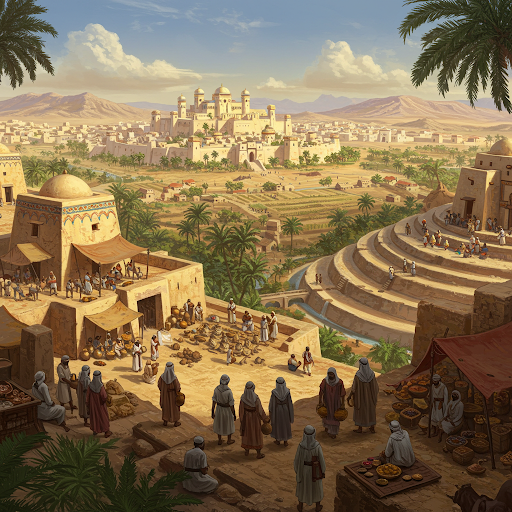The Berbers, also known as the Numidians and Mauretanians, were the indigenous peoples of North Africa, primarily in what is now Morocco, Algeria, Tunisia, and Libya. They played a significant role in ancient history, interacting with Phoenicians, Carthaginians, Romans, and later Islamic civilizations. Their societies were diverse, consisting of nomadic tribes, farmers, traders, and warriors, each adapting to the rugged landscapes of the Maghreb.
This article explores the social structure, housing, clothing, food, economy, religion, governance, and military aspects of daily life among the ancient Berbers.
1. Social Structure: A Tribal Society
Berber society was traditionally tribal and clan-based, with loyalty to family and local leaders.
Hierarchy and Roles
Tribal Chiefs (Amazigh Leaders) – Governed communities, settled disputes, and led warriors.
Farmers and Herders – Formed the majority, cultivating crops and raising livestock.
Merchants and Traders – Engaged in regional and trans-Saharan trade.
Warriors and Horsemen – Fought against invaders and defended trade routes.
Religious Leaders and Shamans – Presided over rituals, maintained oral traditions, and practiced divination.
Despite foreign influences, Berber tribes maintained strong autonomy, often resisting external rule while adopting useful aspects of other cultures.
2. Homes and Settlements
The geography of North Africa, from the Atlas Mountains to the Sahara, shaped Berber housing styles.
Types of Homes
Mudbrick and Stone Houses – Found in villages and cities, often with flat roofs and courtyards.
Cave Dwellings – Built into cliffs or hillsides, offering protection from heat and invaders.
Tents (Khaimas) – Used by nomadic tribes, made of wool and easily transportable.
Larger Berber settlements, such as Cirta (modern Constantine) and Volubilis, became cultural centers influenced by Phoenician, Carthaginian, and later Roman architecture.
3. Clothing and Personal Appearance
Berber clothing was designed for harsh desert conditions, offering protection from the sun and cold nights.
Men’s Clothing
Long tunics (djellabas or burnous), often hooded, made of wool or linen.
Loose-fitting trousers (sarouel) for ease of movement.
Head coverings (tagelmust or turban) to shield from sun and sand.
Women’s Clothing
Flowing robes and dresses, often decorated with embroidery and beads.
Jewelry made from silver, coral, and amber, including necklaces and earrings.
Veils or shawls, depending on regional customs.
Berbers were known for their elaborate hairstyles and tattoos, which held cultural and religious significance.
4. Food and Diet: Surviving in the Maghreb
Despite the arid climate, Berbers developed agriculture and trade-based food systems.
Staple Foods
Wheat and barley – Used for making flatbreads (kesra) and porridge.
Dates, figs, and olives – Essential fruits grown in oases.
Legumes and nuts – Chickpeas, lentils, and almonds were common.
Meat and Dairy
Goat, lamb, and camel meat – Consumed occasionally, often during feasts.
Milk and cheese – Derived from goats and camels, used in daily meals.
Beverages
Herbal teas, including mint tea, were widely consumed.
Fermented drinks made from barley or honey were used in ceremonies.
Trade with Carthaginians, Romans, and Egyptians introduced new foods like wine, olive oil, and exotic spices.
5. Trade and Economy: Masters of the Desert
Berbers played a vital role in trans-Saharan trade, connecting North Africa with the Mediterranean and West Africa.
Major Trade Goods
Gold, ivory, and slaves from sub-Saharan Africa.
Salt from the Sahara, essential for preservation.
Dyes, textiles, and ceramics from Carthage and the Mediterranean.
Berber traders established caravan routes, using camels to navigate the desert. Cities like Tingis (Tangier) and Sabratha became wealthy trade hubs.
6. Religion and Beliefs
Before Roman and Islamic influences, Berbers followed indigenous animist and polytheistic beliefs.
Gods and Spiritual Practices
Gurzil – A war god associated with strength and victory.
Amun – Adopted from Egyptian influence, linked to the sun.
Tanit and Baal – Borrowed from Phoenician and Carthaginian culture.
Religious Rituals
Animal sacrifices and offerings to honor deities.
Ancestor worship, believing spirits guided the living.
Sacred symbols and tattoos, often related to fertility and protection.
With Roman rule, many Berbers converted to Christianity, and later, during Arab expansion, Islam became dominant.
7. Governance and Law
Kingdoms and Tribal Leadership
Numidia (202 BCE – 46 BCE) – Ruled by kings like Masinissa and Jugurtha, who fought against Rome.
Mauretania (110 BCE – 44 CE) – A Berber kingdom influenced by Roman culture.
Even under Roman and later Arab rule, Berber tribes maintained independent governance through councils and chiefs.
Law and Justice
Customary laws (Izref) dictated justice based on tribal traditions.
Mediation by elders resolved disputes within and between tribes.
Severe penalties for theft, betrayal, and dishonor.
8. Military and Warfare
Berbers were known as fierce warriors, skilled in guerilla tactics, cavalry warfare, and desert survival.
Weapons and Tactics
Spears, swords, and daggers for close combat.
Bows and javelins for ranged attacks.
War horses and camels provided mobility in battle.
Famous Berber Warriors
Jugurtha (118–105 BCE) – Led a resistance against Rome.
Tacfarinas (1st century CE) – Fought against Roman occupation.
Berber resistance continued even under the Byzantines and early Islamic Caliphates, with leaders like Kahina and Tariq ibn Ziyad shaping later history.
Conclusion: A Lasting Legacy
The Berbers of Numidia and Mauretania were skilled traders, warriors, and farmers, leaving a lasting impact on North African culture, language, and architecture. Despite foreign conquests, Berber identity remained strong, influencing modern Moroccan, Algerian, Tunisian, and Libyan cultures. Today, Berber traditions, from language to art and festivals, continue to be celebrated across North Africa.



































